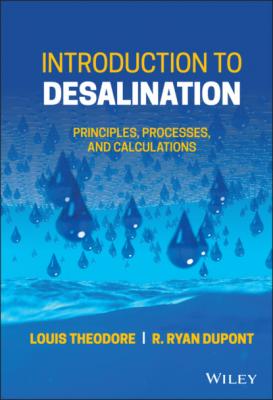Introduction to Desalination. Louis Theodore
Чтение книги онлайн.
Читать онлайн книгу Introduction to Desalination - Louis Theodore страница 11

On examining Table 1.3 it becomes immediately obvious that Antarctica has by far the largest amount of fresh water of any continent. However, this fresh water is in the form of glaciers and permeant ice caps, thus making it unusable. When comparing usable water resources, the top three continents are Asia, with roughly 7,830,622 km3 of water, Africa, with approximately 5,531,776 km3of water, and North America, with 4,327,003 km3 of total usable water resources. Furthermore, these three continents contain over 75% of the usable water on Earth. With this large amount of water being contained in three of the seven continents, mankind has adapted through the development of artificial reservoirs. These artificial reservoirs are most commonly constructed by the creation of a dam around an existing natural water source. Today, it is estimated that there are more than 515,000 of these man-made reservoirs of greater than 2.5 ac in size that cover roughly 258,000 km2 of the Earth’s surface (Osborn 2019).
Table 1.4 summarizes the annual renewable fresh water resources for the top 25 countries in the world. Renewable fresh water resources are an estimate of the average precipitation, recharged groundwater, and fresh surface inflows from surrounding countries that each of these countries receives in any given year. What is interesting to note from these data is that despite a country having a great deal of renewable fresh water resources, water shortages and unequal distribution of resources can still take place. Consider Brazil, which tops the list with over 8,233 km3 of renewable fresh water each year. Despite what would appear to be an abundance of fresh water, Brazil is experiencing a long-term water crisis caused by poor water infrastructure and water resource management which has left over 5 million, or more than 2% of its citizens without access to safe potable water (Water.org 2019).
Table 1.4 Renewable annual fresh water resources for top 25 countries (Table 1.4 Advameg, Inc. 2010).
| Rank | Country | Total fresh water renewable resource, km3 |
|---|---|---|
| 1 | Brazil | 8,233 |
| 2 | Russia | 4,498 |
| 3 | Canada | 3,300 |
| 4 | United States | 3,069 |
| 5 | Indonesia | 2,838 |
| 6 | China | 2,830 |
| 7 | Colombia | 2,132 |
| 8 | Peru | 1,913 |
| 9 | India | 1,908 |
| 10 | Democratic Republic of the Congo | 1,283 |
| 11 | Venezuela | 1,233 |
| 12 | Bangladesh | 1,211 |
| 13 | Burma | 1,046 |
| 14 | Chile | 922 |
| 15 | Vietnam | 891 |
| 16 | Republic of the Congo | 832 |
| 17 | Argentina | 814 |
| 18 | Papua New Guinea | 801 |
| 19 | Bolivia | 622 |
| 20 | Malaysia | 580 |
| 21 | Philippines | 479 |
| 22 | Cambodia | 476 |
| 23 | Mexico | 457 |
| 24 | Ecuador | 432 |
| 25 | Japan | 430 |
Even in what is considered a highly advanced country like the United States, which receives 3,069 km3 a year of renewable fresh water and has historically invested in water infrastructure as well as the management of its water resources, it is estimated that as of 2014, 1.6 million people (0.5% of its population) were without a toilet, a tub or shower, or running water (UNC Environmental Finance Center 2017). Despite availability of renewable fresh water resources, equitable and affordable supply and access to these resources remain a significant challenge, particularly to minority and low-income communities, even in the most developed countries